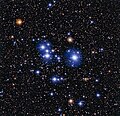Top Qs
Timeline
Chat
Perspective
Messier 47
Open cluster in the constellation Puppis From Wikipedia, the free encyclopedia
Remove ads
Messier 47 (M47 or NGC 2422), also known as NGC 2478[3] is an open cluster in the mildly southern constellation of Puppis. It was discovered by Giovanni Batista Hodierna before 1654 and in his then keynote work re-discovered by Charles Messier on 1771.[a] It was also independently discovered by Caroline Herschel.
There is no cluster in the position indicated by Messier, which he expressed in terms of its right ascension and declination with respect to the star 2 Puppis. However, if the signs (+ and −) he wrote are swapped, the position matches.[4] Until this equivalency was found, M47 was considered a lost Messier Object. This identification as the same thing (ad idem) only came in 1959 with a realization by Canadian astronomer T. F. Morris.[5]
M47 is centered about 1,600 light-years away and is about 78 million years old. The member stars have been measured down to about red dwarfs at apparent magnitude 19. There are around 500 members,[1] the brightest being HD 60855, a magnitude 5.7 Be star. The cluster is dominated by hot class B main sequence and giant stars, but a noticeable colour contrast comes from its brightest red giants.[5]
It about a degree from Messier 46, which is much older and much further away.[5]
Remove ads
Gallery
- Image of star cluster Messier 47 taken using the Wide Field Imager camera, installed on the MPG/ESO 2.2-metre telescope at ESO’s La Silla Observatory in Chile.
See also
References and footnotes
External links
Wikiwand - on
Seamless Wikipedia browsing. On steroids.
Remove ads


